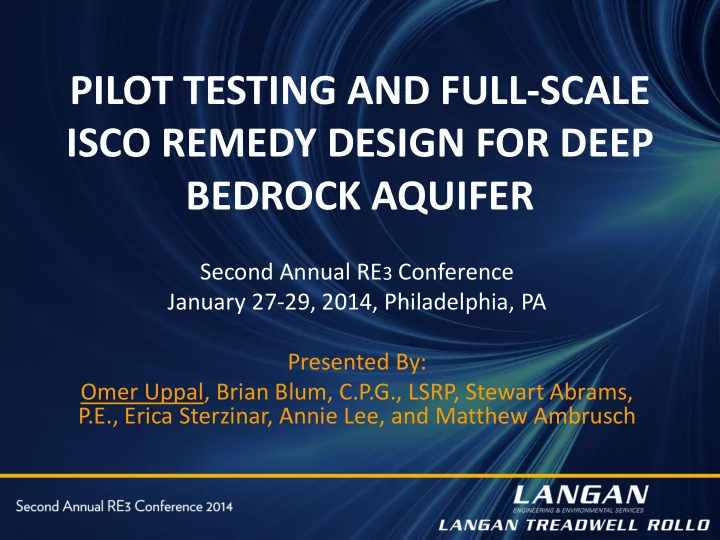

PILOT TESTING AND FULL-SCALE ISCO REMEDY DESIGN FOR DEEP BEDROCK AQUIFER Second Annual RE 3 Conference January 27-29, 2014, Philadelphia, PA Presented By: Omer Uppal, Brian Blum, C.P.G., LSRP, Stewart Abrams, P.E., Erica Sterzinar, Annie Lee, and Matthew Ambrusch
PRESENTATION OUTLINE • Site Background • Remedial Approach • Phase I Pilot Test • Injection Implementation • Testing Results • Phase II Pilot Test • Hydraulic Fracturing • Injection Implementation • Testing Results Synopsis • Conclusions • Proposed Full-Scale ISCO Remedy Design
SITE BACKGROUND • 98 Acre Former Industrial R&D Facility • Trichloroethene (TCE) impacts in soil and groundwater Groundwater • Groundwater Flow Direction concentrations of TCE up to 59,000 ppb (PIW-1B, Nov 2011) • Bulk of TCE impacts in the intermediate bedrock zone • 155 tons of source area soil removed in 2006 Extent of TCE Plume (1 ppb)
SITE GEOLOGY • Unstratified Glacial Deposits • Bedrock (Diorite) Diorite fragments from well drilling Photographer: Siim Sepp, 2005, Source: Wikipedia
REMEDIAL APPROACH Why Potassium Permanganate? • Bedrock expected to have low SOD (0.1-0.65 g/kg), enabling chemical oxidation to be more cost effective • Known to be effective for removal of chlorinated ethenes 2KMnO 4 + C 2 HCl 3 2CO 2 + 2MnO 2 + 3Cl - + H + + 2K + • Relatively short remedial timeframe • MnO 4 - Relatively long subsurface half-life (months to years) Permanganate - + 4H + + 3e - → MnO 2(s) + 2H 2 O MnO 4 E ° = 1.70 V
PHASE I ISCO PILOT TEST 3 Injection Wells: • Shallow bedrock • Intermediate bedrock • deep bedrock
FIELD IMPLEMENTATION Automated Portable Bulk Feed System ( Vironex )
INJECTION VOLUMES * 97% of solution injected into the deep bedrock zone
INJECTION SUMMARY • 6,081 gallons of 2.5% potassium permanganate • 1,260 lbs of oxidant • Three day operation
INJECTION OBSERVATIONS • Shallow and Intermediate Bedrock : No measureable flow at injection pressures up to 100 psi • Deep Bedrock : Able to inject at flow rates ranging from 5 to 22 gpm at a pressure up to 60 psi
RADIUS OF INFLUENCE Color (Permanganate = Purple) • Observed pink water at MW-12C Groundwater Mounding • Observed groundwater mounding at MW-12C, MW- 16B, MW-17B and MW-12D. *Radius of influence for the deep zone is at least 25 feet
PHASE I TESTING RESULTS Analytical Results: • 99% reduction in TCE at PIW-1C, where the majority of the solution was injected • 62% reduction in TCE at MW-12C, the directly downgradient deep monitoring well
PHASE I TESTING RESULTS Geochemical Parameters: ORP pH
PHASE I TESTING RESULTS • ISCO is a feasible remedial technology for the site. • Concentrations did not decrease significantly due to the inability to inject in the intermediate bedrock zone. • Hydraulic fracturing needed to achieve reasonable injection rates in the intermediate bedrock zone (Phase II)
PHASE II ISCO PILOT TEST Objectives: • Obtain injection flow-pressure relationships for full- scale remedial design • Evaluate strategies to increase chemical distribution • Evaluate effectiveness of hydraulic fracturing to facilitate injection in the intermediate bedrock zone
FIELD IMPLEMENTATION Methodology and Operation: • Installed an additional intermediate injection well (PIW- 2B) • Hydro-fractured PIW-2B • Injected 2,000 gallons of 2.5% KMnO 4 (452 lbs) in PIW-2B
HYDRAULIC FRACTURING OVERBURDEN OVERBURDEN WEATHERED BEDROCK WEATHERED BEDROCK DIORITE DIORITE • Fracturing of rock by a pressurized liquid • Increases connectivity of aquifer and well yield • Performed at PIW-2B at 100-150 bgs, where highest TCE concentrations observed, by Northeast Water Production, Inc. • Direct hydraulic connection was observed, as a function of water level fluctuations, between PIW-2B and PIW-1C following hydro-fracturing.
INJECTION OBSERVATIONS • Hydraulic fracturing can achieve flow rates of up to 15 gpm at pressures less than 50 psi. • Hydraulic influence was observed at distances up to 125 feet during injection. • Groundwater daylighting was observed at PIW-1C. Visual evidence of permanganate solution in PIW-1A
PHASE II TESTING RESULTS • Oxidant distribution at distances up to 125 feet downgradient • Oxidant was present at several wells during the post injection sampling round • No indication of rebound at PIW-1B Notes: ‒ -- = Sample not collected ‒ Sampled via passive diffusion bag (PDB) samplers ‒ NJDEP GWQS for TCE = 1 ppb
PHASE II TESTING RESULTS • ISCO is feasible for the intermediate bedrock zone. • Hydro-fracturing can significantly enhance oxidant injection rates and distribution in the subsurface. • A larger scale injection well network will be more effective in distributing oxidant and reducing TCE concentrations.
FULL-SCALE ISCO REMEDY DESIGN Remedial Strategy: • Installation of six additional intermediate bedrock zone injection wells, one extraction well • Hydraulic fracturing of select injection wells • ISCO with NaMnO 4 • Groundwater extraction at select monitoring wells along the downgradient site boundary while injecting oxidant “Push - Pull ISCO Approach”
PUMP/WELL YIELD TESTING Performed in April 2013 at seven monitoring wells to verify achievable extraction rates that can be sustained during ISCO injection. Tests Performed: 1. Specific capacity (step-drawdown) aquifer pumping tests • Flow rates at individual wells ranged from 0.15 to 1.5 gpm 2. Constant-rate aquifer pumping test • Conducted at seven wells simultaneously at 5 gpm (combined pumping flow rate)
PUMP/WELL YIELD TESTING RESULTS
FULL-SCALE ISCO DESIGN • Total mass of 40% NaMnO 4 = 61,100 lbs • Target NaMnO 4 injection solution concentration = 7.5% to 10% • Total injection volume = 27,400 to 37,200 gallons • Design injection rate = 10 gpm (over 6 hours/day) • Design extraction rate = 3 gpm (over 8 hours/day) Implementation Planned for Summer 2014
FULL-SCALE ISCO DESIGN
ISCO EQUIPMENT AND MANIFOLD LAYOUT
QUESTIONS? Source: Google Maps
Recommend
More recommend